
The stamen is the pollen-producing reproductive organ of a flower. Collectively the stamens form the androecium.

Clarkia is a genus within the flowering plant family Onagraceae. Over 40 species are currently classified in Clarkia; almost all are native to western North America, though one species is native to South America.

Calyceraceae is a plant family in the order Asterales. The natural distribution of the about sixty species belonging to this family is restricted to the southern half of South America. The species of the family resemble both the family Asteraceae and the Dipsacaceae.

43 we 4 we e d e 24w re

Hygrophila, commonly known as swampweeds, is a genus of flowering plants in the acanthus family, Acanthaceae. There are about 80 to 100 species, of which many are aquatic plants. The genus is distributed across the tropical and subtropical world. It is one of only two genera in its family that contains aquatic plants, the other being Justicia. The genus is treated in the tribe Hygrophileae, which is noted as being in need of revision at the genus level, meaning the current taxonomic boundaries of Hygrophila are likely to change in the future.
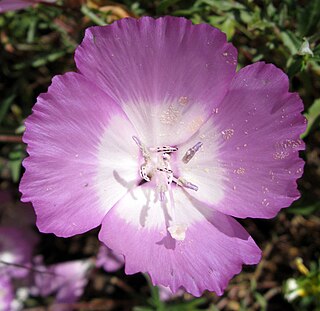
Clarkia bottae is a species of wildflower with several common names, including punchbowl godetia, Botta's clarkia, Botta's fairyfan, and hill clarkia.
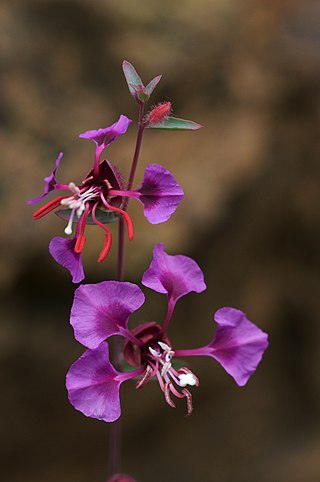
Clarkia unguiculata is a species of wildflower known by the common name elegant clarkia or mountain garland. This plant is endemic to California, where it is found in many woodland habitats. Specifically it is common on the forest floor of many oak woodlands, along with typical understory wildflowers that include Calochortus luteus, Cynoglossum grande and Delphinium variegatum. C. unguiculata presents a spindly, hairless, waxy stem not exceeding a meter in height and bears occasional narrow leaves. The showy flowers have hairy, fused sepals forming a cup beneath the corolla, and four petals each one to 2.5 centimeters long. The paddle-like petals are a shade of pink to reddish to purple and are slender and diamond-shaped or triangular. There are eight long stamens, the outer four of which have large red anthers. The stigma protrudes from the flower and can be quite large. Flowers of the genus Clarkia are primarily pollinated by specialist bees found in their native habitat "Clarkias independently developed self-pollination in 12 lineages."
Clarkia australis is a species of flowering plant in the evening primrose family known by the common name Small's southern clarkia. It is endemic to California, where it grows in the forests of the central Sierra Nevada. It is an uncommon species threatened by such forest activities as logging. This annual herb produces a slender, erect stem approaching a meter in height. The leaves are widely linear in shape and borne on short petioles. The top of the stem is occupied by the tall inflorescence, which bears hanging buds that open from the lowest upward so that there are several closed buds above open flowers. The sepals do not remain fused as the flower opens. The petals are diamond-shaped and sometimes lobed and curling at the tip. They are mottled or spotted lavender, purple, and reddish in color, and each is up to 1.5 centimeters long. There are 8 long stamens tipped with large anthers bearing blue-gray pollen. The stigma protrudes past the anthers.
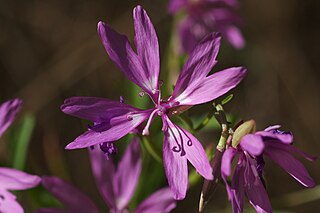
Clarkia biloba is a species of flowering plant in the evening primrose family known by the common name twolobe clarkia and two lobed clarkia.
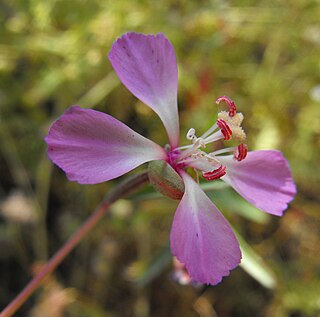
Clarkia delicata is a rare species of flowering plant in the evening primrose family known by the common names Campo clarkia and delicate clarkia. It is native to northern Baja California and adjacent San Diego County, California, where it grows in the woodland and chaparral of the Peninsular Ranges. This is an annual herb producing an erect stem just over half a meter in maximum height. The leaves are oval or widely lance-shaped, up to 4 centimeters long, and borne on very short petioles. The top of the stem is occupied by the inflorescence, in which the lower flowers open while the upper buds hang closed. The sepals remain fused as the flower blooms from one side. Each unlobed oval petal is about a centimeter long and pink to pinkish-lavender. There are 8 stamens, some with large orange anthers and some with smaller, paler anthers. There is also a protruding stigma with four large, fuzzy lobes.
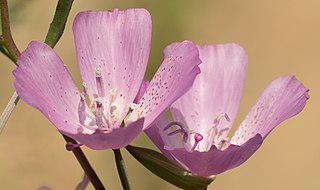
Clarkia dudleyana is a species of flowering plant in the evening primrose family known by the common name Dudley's clarkia. It is endemic to California, where it can be found in the mountains of the Transverse Ranges and the southern Sierra Nevada foothills. It grows in woodland, forest, and chaparral habitats under 1500 meters in elevation. This annual herb produces an erect stem sometimes exceeding half a meter in height. The leaves are lance-shaped, up to 7 centimeters long, and borne on short petioles. The top of the stem is occupied by the inflorescence, which has opening flowers below closed, hanging buds. As the flower blooms the pink to reddish-purple sepals remain fused, opening along one side only. The petals are up to 3 centimeters long, fan-shaped, pinkish lavender in color and sometimes flecked with red. There are 8 stamens, some of which have large lavender anthers and some that have smaller, paler anthers. The stigma protrudes farther than the stamens.

Clarkia exilis is a small herbaceous annual plant of western North America. It is an uncommon species in the evening primrose family known by the common names Kern River clarkia and slender clarkia.
Clarkia lewisii is an uncommon species of flowering plant in the evening primrose family known by the common name Lewis' clarkia. It is endemic to California, where it is known from the hills and mountains of Monterey and San Benito Counties. It is an erect annual herb generally under half a meter in height. The lance-shaped leaves are a few centimeters long. The inflorescence bears opening flowers and closed, hanging flower buds. As the bud opens the pink or purple sepals stay fused as the petals bloom from one side. The fan-shaped petals are up to 3 centimeters long, pink to lavender with white and red coloration near the bases. There are 8 stamens and a protruding stigma.
Clarkia rostrata is a species of flowering plant in the evening primrose family known by the common name beaked clarkia.

Clarkia springvillensis is a rare species of flowering plant in the evening primrose family known by the common name Springville clarkia. It is endemic to central Tulare County, California, where it is known from fewer than 20 occurrences around Springville. It is a federally listed threatened species.

Papilionaceous flowers are flowers with the characteristic irregular and butterfly-like corolla found in many, though not all, plants of the species-rich Faboideae subfamily of legumes. Tournefort suggested that the term Flores papilionacei originated with Valerius Cordus, who applied it to the flowers of the bean.

Ribes thacherianum, with the common name Santa Cruz gooseberry, or Santa Cruz Island gooseberry, is a rare North American species of currant found only on one island off the coast of California.
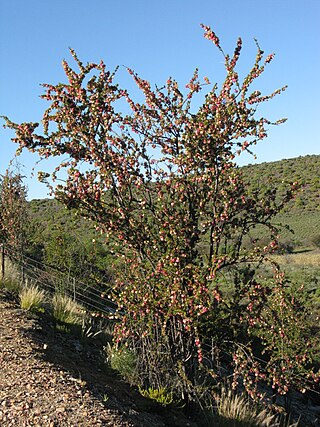
Nymania capensis is a species of plant known in English as "Chinese lantern" because of the shape of its bright, colourful fruit, and in Afrikaans as "klapper". It is the only species in the genus Nymania. It is a spare, scrubby, woody shrub or small tree, typically ) 0.5–3 m tall. It is endemic to South Africa and some closely bordering territories, especially inland regions in central, northern and eastern parts. It grows mainly in Karooid regions, among the scrub of gorges, but also in open veld and river banks in the Great and Little Karoo, Namaqualand and Kalahari. The leaves are alternate and fascicled. They are simple and more or less linear. The flowers are solitary, born on pedicels in axils. The corolla and calyx have four lobes each, with eight stamens inserted at the base of the disc, the filaments being connate at their base. The ovary is superior and sessile; it has four lobes and four locules, each containing two collateral ascending ovules. The stigma is simple and the style extends further than the stamens. The fruit is an inflated membranous capsule, 3–5 cm across, each locule forming a distinct lobe. The ripe seeds are hard and rounded, some 2–4 mm in diameter. A locule may contain less than two seeds, due to abortion.
Annona angustifolia is a species of plant in the Annonaceae family. It is native to Brazil. Jacques Huber, the Swiss-Brazilian botanist who first formally described the species, named it after its narrow leaves.

In botany, floral morphology is the study of the diversity of forms and structures presented by the flower, which, by definition, is a branch of limited growth that bears the modified leaves responsible for reproduction and protection of the gametes, called floral pieces.

















